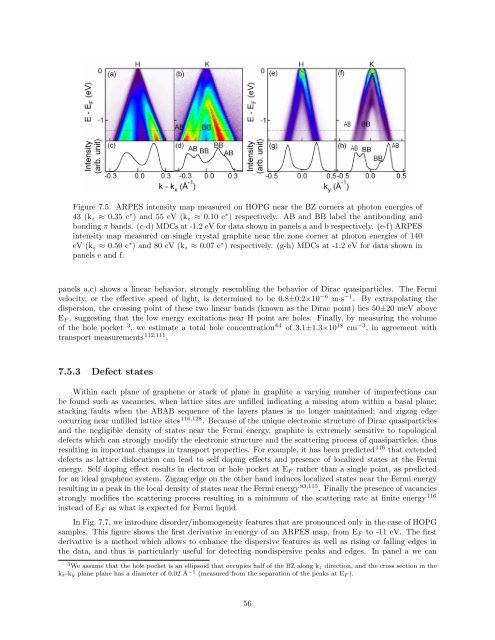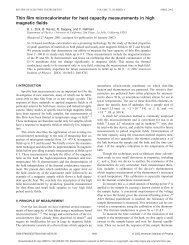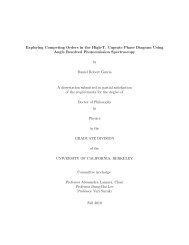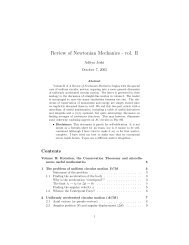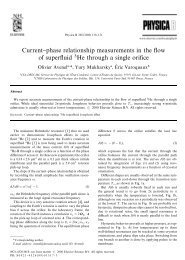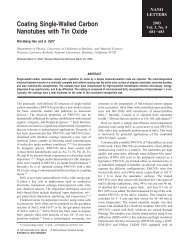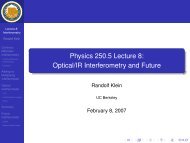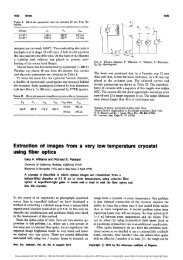Dirac Fermions in Graphene and Graphiteâa view from angle ...
Dirac Fermions in Graphene and Graphiteâa view from angle ...
Dirac Fermions in Graphene and Graphiteâa view from angle ...
You also want an ePaper? Increase the reach of your titles
YUMPU automatically turns print PDFs into web optimized ePapers that Google loves.
Figure 7.5. ARPES <strong>in</strong>tensity map measured on HOPG near the BZ corners at photon energies of<br />
43 (k z ≈ 0.35 c ∗ ) <strong>and</strong> 55 eV (k z ≈ 0.10 c ∗ ) respectively. AB <strong>and</strong> BB label the antibond<strong>in</strong>g <strong>and</strong><br />
bond<strong>in</strong>g π b<strong>and</strong>s. (c-d) MDCs at -1.2 eV for data shown <strong>in</strong> panels a <strong>and</strong> b respectively. (e-f) ARPES<br />
<strong>in</strong>tensity map measured on s<strong>in</strong>gle crystal graphite near the zone corner at photon energies of 140<br />
eV (k z ≈ 0.50 c ∗ ) <strong>and</strong> 80 eV (k z ≈ 0.07 c ∗ ) respectively. (g-h) MDCs at -1.2 eV for data shown <strong>in</strong><br />
panels e <strong>and</strong> f.<br />
panels a,c) shows a l<strong>in</strong>ear behavior, strongly resembl<strong>in</strong>g the behavior of <strong>Dirac</strong> quasiparticles. The Fermi<br />
velocity, or the effective speed of light, is determ<strong>in</strong>ed to be 0.8±0.2×10 −6 m·s −1 . By extrapolat<strong>in</strong>g the<br />
dispersion, the cross<strong>in</strong>g po<strong>in</strong>t of these two l<strong>in</strong>ear b<strong>and</strong>s (known as the <strong>Dirac</strong> po<strong>in</strong>t) lies 50±20 meV above<br />
E F , suggest<strong>in</strong>g that the low energy excitations near H po<strong>in</strong>t are holes. F<strong>in</strong>ally, by measur<strong>in</strong>g the volume<br />
of the hole pocket 3 , we estimate a total hole concentration 64 of 3.1±1.3×10 18 cm −3 , <strong>in</strong> agreement with<br />
transport measurements 112,111 .<br />
7.5.3 Defect states<br />
With<strong>in</strong> each plane of graphene or stack of plane <strong>in</strong> graphite a vary<strong>in</strong>g number of imperfections can<br />
be found such as vacancies, when lattice sites are unfilled <strong>in</strong>dicat<strong>in</strong>g a miss<strong>in</strong>g atom with<strong>in</strong> a basal plane;<br />
stack<strong>in</strong>g faults when the ABAB sequence of the layers planes is no longer ma<strong>in</strong>ta<strong>in</strong>ed; <strong>and</strong> zigzag edge<br />
occurr<strong>in</strong>g near unfilled lattice sites 116,128 . Because of the unique electronic structure of <strong>Dirac</strong> quasiparticles<br />
<strong>and</strong> the negligible density of states near the Fermi energy, graphite is extremely sensitive to topological<br />
defects which can strongly modify the electronic structure <strong>and</strong> the scatter<strong>in</strong>g process of quasiparticles, thus<br />
result<strong>in</strong>g <strong>in</strong> important changes <strong>in</strong> transport properties. For example, it has been predicted 116 that extended<br />
defects as lattice dislocation can lead to self dop<strong>in</strong>g effects <strong>and</strong> presence of localized states at the Fermi<br />
energy. Self dop<strong>in</strong>g effect results <strong>in</strong> electron or hole pocket at E F rather than a s<strong>in</strong>gle po<strong>in</strong>t, as predicted<br />
for an ideal graphene system. Zigzag edge on the other h<strong>and</strong> <strong>in</strong>duces localized states near the Fermi energy<br />
result<strong>in</strong>g <strong>in</strong> a peak <strong>in</strong> the local density of states near the Fermi energy 83,115 . F<strong>in</strong>ally the presence of vacancies<br />
strongly modifies the scatter<strong>in</strong>g process result<strong>in</strong>g <strong>in</strong> a m<strong>in</strong>imum of the scatter<strong>in</strong>g rate at f<strong>in</strong>ite energy 116<br />
<strong>in</strong>stead of E F as what is expected for Fermi liquid.<br />
In Fig. 7.7, we <strong>in</strong>troduce disorder/<strong>in</strong>homogeneity features that are pronounced only <strong>in</strong> the case of HOPG<br />
samples. This figure shows the first derivative <strong>in</strong> energy of an ARPES map, <strong>from</strong> E F to -11 eV. The first<br />
derivative is a method which allows to enhance the dispersive features as well as ris<strong>in</strong>g or fall<strong>in</strong>g edges <strong>in</strong><br />
the data, <strong>and</strong> thus is particularly useful for detect<strong>in</strong>g nondispersive peaks <strong>and</strong> edges. In panel a we can<br />
3 We assume that the hole pocket is an ellipsoid that occupies half of the BZ along k z direction, <strong>and</strong> the cross section <strong>in</strong> the<br />
k x-k y plane plane has a diameter of 0.02 Å −1 (measured <strong>from</strong> the separation of the peaks at E F ).<br />
56


